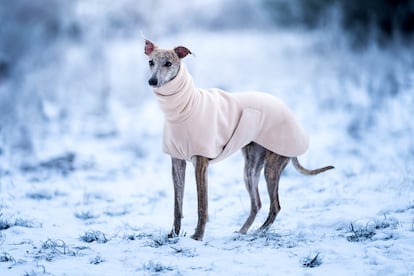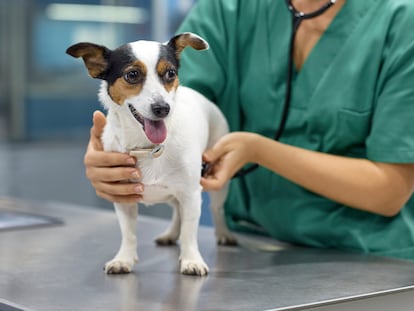How to protect dogs in cold weather: coats work, boots not so much
Dogs catch colds and need to increase their body temperature during the winter, so as to avoid respiratory problems such as kennel cough. Specific clothing for going outside and keeping them at home at an adequate temperature are ways to protect them when the thermometer drops

Winter weather can negatively affect the health of dogs, especially in certain breeds that have less fur — such as the English Pointer — or in snub-nosed dogs, such as the bulldog or the Pekingese, or even in sporting dogs, such as huskies. Like humans, dogs also catch colds.
“They suffer from infectious respiratory processes in the upper respiratory tract. It’s called canine infectious respiratory complex and manifests itself in the so-called kennel cough, or tracheobronchitis,” explains Silvia Miguélez, who works at a veterinary clinic in Madrid.
This condition manifests itself with a sound that’s similar to a human cough. “Its characteristic symptom is an abrupt and unmistakable guttural sound, but there’s also another new variant similar to the human common cold, which causes [a watery nose], sneezing and coughing, lasting around 10 days,” the veterinarian describes. She recommends non-mandatory vaccinations for dogs, in order to prevent these diseases in winter.
How to shelter your dog during their walk
Specific clothing for dogs in winter is useful to protect them from both the cold and humidity, either when it rains or snows. Of course, these articles of clothing must have certain characteristics to be effective: “The inner side must be warm and the outer side must have a windproof and waterproof layer. The size should cover the neck and rib cage well, like a horse blanket,” Silvia Miguélez emphasizes. There are several options of coats for dogs: “One is [a raincoat] for rainy days, which, to a certain extent, saves having to dry the dog after a walk in the rain,” the specialist adds.
It’s also important that dogs have an appropriate temperature indoors. In winter, they feel comfortable at home with a temperature of around 68 degrees Fahrenheit. “They’ll choose the area where they’re most comfortable and that’s where their bed or blanket can be placed,” the veterinarian specifies. It must be taken into account that each dog breed has different needs. “A malamute isn’t the same as a pointer. Some get less cold than others, depending on their coat and complexion.”

How dogs handle humidity and the cold
When it rains or snows, it’s important to dry the dog when returning home from a walk, especially if they’re a long-haired breed. “It’s advisable to do this for its well-being, because wet fur generates unpleasant odors, especially if the animal hasn’t been washed in a while: the effect is similar to what happens with a wet kitchen cloth,” Silvia Miguélez warns. “A good idea is to leave a towel on hand to dry them as soon as you enter the house and then comb or brush them. This also removes dead hair and, if necessary — if they have very long hair — you can use the dryer,” she suggests.
Paw pads and the cold
The skin of the dog’s paw pads is prepared to withstand the cold and, under normal conditions, they don’t require special protection. “It’s different, for example, in the case of sled dogs, who participate in races with distances of about 40 miles a day at very low temperatures,” the specialist continues. However, in most conditions, she warns about the misuse of dog boots: “It alters the support point of the limb — especially the pads — so its use should be restricted to trained athletic dogs.” However, the skin on the soles of dogs’ paws is resistant. “It’s harder and rougher. It’s prepared to withstand contact with the ground at both low and high temperatures,” explains Roberto Elices-Mínguez, a veterinarian and professor of Animal Nutrition at the Faculty of Veterinary Medicine of Madrid (UCM).
The temperature of dogs versus people
Dogs have a higher body temperature than people, around 101.3 degrees Fahrenheit. “They’re considered to have a fever when [their temperature reaches] over 103.1 degrees and don’t need extra energy to maintain constant body heat,” Elices-Mínguez explains. The regulation of canine body temperature is multifactorial. “It has to do with age, skin thickness, coverage, the predominant type of hair or fat on the body and the ability to acclimatize to the environment,” the veterinarian lists. “To reduce the dog’s energy expenditure that occurs with the cold, in addition to protecting them with specific outdoor clothing, the animal’s daily food ration can be increased during the winter, always under veterinary supervision,” this specialist advises.
However, it must be taken into account that the use of coats isn’t natural for dogs. “There may be some initial reluctance on the part of the animal to wear clothing, which can leave them feeling [restricted]. It’s a matter of gradually getting used to it,” Elices-Mínguez concludes.
Sign up for our weekly newsletter to get more English-language news coverage from EL PAÍS USA Edition
Tu suscripción se está usando en otro dispositivo
¿Quieres añadir otro usuario a tu suscripción?
Si continúas leyendo en este dispositivo, no se podrá leer en el otro.
FlechaTu suscripción se está usando en otro dispositivo y solo puedes acceder a EL PAÍS desde un dispositivo a la vez.
Si quieres compartir tu cuenta, cambia tu suscripción a la modalidad Premium, así podrás añadir otro usuario. Cada uno accederá con su propia cuenta de email, lo que os permitirá personalizar vuestra experiencia en EL PAÍS.
¿Tienes una suscripción de empresa? Accede aquí para contratar más cuentas.
En el caso de no saber quién está usando tu cuenta, te recomendamos cambiar tu contraseña aquí.
Si decides continuar compartiendo tu cuenta, este mensaje se mostrará en tu dispositivo y en el de la otra persona que está usando tu cuenta de forma indefinida, afectando a tu experiencia de lectura. Puedes consultar aquí los términos y condiciones de la suscripción digital.
More information
Últimas noticias
Most viewed
- Sinaloa Cartel war is taking its toll on Los Chapitos
- Oona Chaplin: ‘I told James Cameron that I was living in a treehouse and starting a permaculture project with a friend’
- Reinhard Genzel, Nobel laureate in physics: ‘One-minute videos will never give you the truth’
- Why the price of coffee has skyrocketed: from Brazilian plantations to specialty coffee houses
- Silver prices are going crazy: This is what’s fueling the rally











































